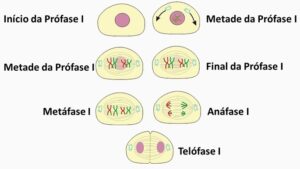


Spindle fibers attach to kinetochores, to which they attach when separating sister chromatids.Īnaphase I: Homologous pairs separate, with two chromatids going to each of the two poles.Īnaphase II: Chromosomes divide at the centromeres, with one chromatid going to each of the two poles. Metaphase II: Chromosomes align single file. Metaphase I: Homologous chromosomes align side-by-side, in random order (either paternal or maternal chromosome align to each side). Prophase II: Chromatin condenses into chromosomes. Has five substages: Leptotene, Zygotene, Pachytene, Diplotene, and Diakinesis. Genetic recombination occurs (crossing-over). Prophase I: Chromosomes form a tetrad, joined at the chiasmata. In some species, starts with interkinesis or Interphase II, which lacks an S phase as the DNA has already been replicated, and does not result in chromosome duplication, instead of interphase. No DNA replication takes place in Meiosis II.įeatures G1 phase, S phase, and G2 phase genetic replication occurs. 85%-95% of total time for both divisions is spent in prophase I. Homotypic or equational division (haploid cells to haploid cells) Heterotypic or reduction division (diploid cell to haploid cells) In both meiosis I and II, cytokinesis occurs, and there are two daughter cells per parent cell.Ĭomparison chart Meiosis I versus Meiosis II comparison chart Meiosis II is generally regarded as being very similar to mitosis, except for the presence of two parent cells, instead of only one. Meiosis I, also produces cells in which the chromosomes are still whole and are composed of two chromatids on the other hand, the separation of sister chromatids occurs in meiosis II. Meiosis II, being an equational division, does not feature a change in ploidy it instead produces haploid daughter cells from haploid parent cells. The first meiotic stage is also an example of reductional division, wherein a change in ploidy takes place as a diploid parent cell forms haploid daughter cells. Genetic reassortment occurs during meiosis I. Meiosis forms gametes, or sex cells, by rearranging and mixing genetic material, which ensures genetically-distinct progeny (children) and sufficient variety in the gene pool.īecause meiosis begins with one diploid parent cell and ends with four haploid daughter cells, two division stages are needed: these divisions are called meiosis I and meiosis II. Meiosis is a form of cell division that usually occurs only once in the lifetime of a eukaryote, and is vital to the sexual reproduction of eukaryotic organisms. During this process, the microtubules alternately (and quickly) assemble and disassemble as they try to find their ways toward the kinetochores found at the centromeres of each sister chromatid.Diffen › Science › Biology › Cellular Biology Sometimes, biologist define a so-called intermediate phase between prophase and metaphase: prometaphase.Note: The disintegration of the nuclear envelope is not a universal characteristic of mitosis as organisms like yeasts exhibit a so-called “ closed mitosis” where the envelope remains intact. The end of prophase is the breakdown of the nuclear envelope (in higher eukaryotes which will help for the easier release of the chromosomes.Here, the centrosomes will serve as the guide for the mitotic spindle (pairs of centrioles). The centrosomes, which were previously replicated during interphase, begin to separate and migrate to the opposite sides of the cell.Aside from condensation, the mitotic spindle fibre, which will further help in the segregation of the chromosomes, is also formed due to various cytoplasmic changes in the cell.During prophase, the chromatin coils into visible rod-shaped structures called the chromosomes.These DNA molecules were previously produced and duplicated during the S phase in the interphase. Mitosis Prophase and Prometaphase (Source: Wikimedia)The condensation of the chromatin (consisting of two sister chromatids) marks the beginning of prophase.


 0 kommentar(er)
0 kommentar(er)
